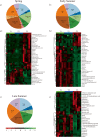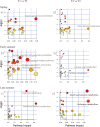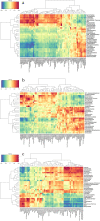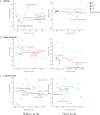Differential responses of the rhizosphere microbiome structure and soil metabolites in tea (Camellia sinensis) upon application of cow manure
- PMID: 35164712
- PMCID: PMC8842532
- DOI: 10.1186/s12866-022-02470-9
Differential responses of the rhizosphere microbiome structure and soil metabolites in tea (Camellia sinensis) upon application of cow manure
Abstract
Background: The rhizosphere is the narrow zone of soil immediately surrounding the root, and it is a critical hotspot of microbial activity, strongly influencing the physiology and development of plants. For analyzing the relationship between the microbiome and metabolome in the rhizosphere of tea (Camellia sinensis) plants, the bacterial composition and its correlation to soil metabolites were investigated under three different fertilization treatments (unfertilized, urea, cow manure) in different growing seasons (spring, early and late summer).
Results: The bacterial phyla Proteobacteria, Bacteroidetes, Acidobacteria and Actinobacteria dominated the rhizosphere of tea plants regardless of the sampling time. These indicated that the compositional shift was associated with different fertilizer/manure treatments as well as the sampling time. However, the relative abundance of these enriched bacteria varied under the three different fertilizer regimes. Most of the enriched metabolic pathways stimulated by different fertilizer application were all related to sugars, amino acids fatty acids and alkaloids metabolism. Organic acids and fatty acids were potential metabolites mediating the plant-bacteria interaction in the rhizosphere. Bacteria in the genera Proteiniphilum, Fermentimonas and Pseudomonas in spring, Saccharimonadales and Gaiellales in early summer, Acidobacteriales and Gaiellales in late summer regulated relative contents of organic and fatty acids.
Conclusion: This study documents the profound changes to the rhizosphere microbiome and bacterially derived metabolites under different fertilizer regimes and provides a conceptual framework towards improving the performance of tea plantations.
Keywords: Bacterial microbiome; Fertilizer; Metabolome; Organic; Rhizosphere.
© 2022. The Author(s).
Conflict of interest statement
The authors declare that the research was conducted in the absence of any commercial or financial relationships that could be construed as a potential conflict of interest.
Figures






Similar articles
-
Cow manure application effectively regulates the soil bacterial community in tea plantation.BMC Microbiol. 2020 Jul 1;20(1):190. doi: 10.1186/s12866-020-01871-y. BMC Microbiol. 2020. PMID: 32611380 Free PMC article.
-
Correlation among Metabolic Changes in Tea Plant Camellia sinensis (L.) Shoots, Green Tea Quality and the Application of Cow Manure to Tea Plantation Soils.Molecules. 2021 Oct 13;26(20):6180. doi: 10.3390/molecules26206180. Molecules. 2021. PMID: 34684759 Free PMC article.
-
The effects of chemical and organic fertilizer usage on rhizosphere soil in tea orchards.PLoS One. 2019 May 28;14(5):e0217018. doi: 10.1371/journal.pone.0217018. eCollection 2019. PLoS One. 2019. PMID: 31136614 Free PMC article.
-
Unlocking Rhizosphere Dynamics: Exploring Mechanisms of Plant-Microbe Interactions for Enhanced Tea (Camellia sinensis (L.) O. Kuntze) Productivity.Curr Microbiol. 2025 Apr 22;82(6):257. doi: 10.1007/s00284-025-04235-9. Curr Microbiol. 2025. PMID: 40261358 Review.
-
A Review on Rhizosphere Microbiota of Tea Plant (Camellia sinensis L): Recent Insights and Future Perspectives.J Agric Food Chem. 2023 Dec 13;71(49):19165-19188. doi: 10.1021/acs.jafc.3c02423. Epub 2023 Nov 29. J Agric Food Chem. 2023. PMID: 38019642 Review.
Cited by
-
Interplanting potato with grapes improved yield and soil nutrients by optimizing the interactions of soil microorganisms and metabolites.Front Plant Sci. 2024 Sep 9;15:1404589. doi: 10.3389/fpls.2024.1404589. eCollection 2024. Front Plant Sci. 2024. PMID: 39315377 Free PMC article.
-
Differences in microbial community structure and metabolic activity among tea plantation soils under different management strategies.Front Microbiol. 2023 Aug 2;14:1219491. doi: 10.3389/fmicb.2023.1219491. eCollection 2023. Front Microbiol. 2023. PMID: 37601365 Free PMC article.
-
Fermented soybean meal enhances soil health, rhizosphere microenvironment and tea quality via microbial and metabolite changes.Food Chem X. 2025 Jun 24;29:102697. doi: 10.1016/j.fochx.2025.102697. eCollection 2025 Jul. Food Chem X. 2025. PMID: 40686866 Free PMC article.
-
Application of coronarin enhances maize drought tolerance by affecting interactions between rhizosphere fungal community and metabolites.Comput Struct Biotechnol J. 2023 Oct 23;21:5273-5284. doi: 10.1016/j.csbj.2023.10.043. eCollection 2023. Comput Struct Biotechnol J. 2023. PMID: 37954150 Free PMC article.
-
Different changes of bacterial diversity and soil metabolites in tea plants-legume intercropping systems.Front Plant Sci. 2023 Mar 16;14:1110623. doi: 10.3389/fpls.2023.1110623. eCollection 2023. Front Plant Sci. 2023. PMID: 37008505 Free PMC article.
References
-
- Badri DV, Zolla G, Bakker MG, Manter DK, Vivanco JM. Potential impact of soil microbiomes on the leaf metabolome and on herbivore feeding behavior. New Phytol. 2013;198(1):264–273. - PubMed
-
- Zhang X, Zhang Q, Liang B, Li J. Changes in the abundance and structure of bacterial communities in the greenhouse tomato cultivation system under long-term fertilization treatments. Appl Soil Ecol. 2017;121:82–89.
-
- Juana MU, Zwetsloot MJ, Cuellar Gempeler C, Bauerle TL. Spatiotemporal patterns of rhizosphere microbiome assembly: From ecological theory to agricultural application. J Appl Ecol. 2021;58(5):894–904.
Publication types
MeSH terms
Substances
LinkOut - more resources
Full Text Sources

